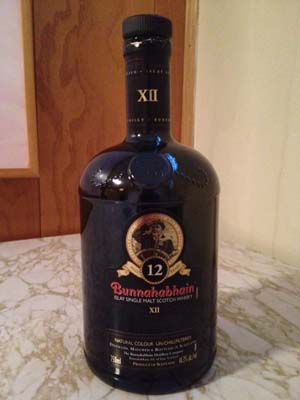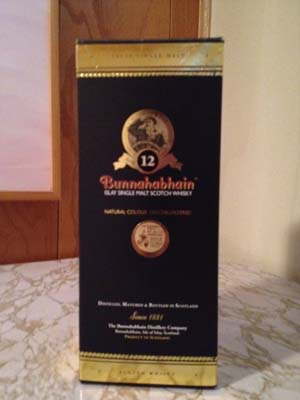Bunnahabhain 12 Year Islay Single Malt Scotch Whisky Review
* This review published in the Islay Daily Newspaper on 7/01/13
http://paper.li/isleofislay?edition_id=1cc8cf00-e266-11e2-a5e1-0025907210e8 *
I have to admit… there is a specific reason why I decided to try a Scotch from the Bunnahabhain distillery. I was talking with one of the Managers at my local liquor store and he said that a patron of theirs got them to start carrying Bunnahabhain (both the 12 year reviewed here and the 18 year). I was pretty open to a new dram and was looking for something interesting and so I thought.. if one of their customers liked it so much that he was able to convince them to start carrying it then it may be something to try. I had seen it at a few other liquor establishments, but to be honest knew very little about the distillery or the Scotch. And so I bought a bottle.
This is the first whisky that I have reviewed that comes from the island of Islay (notice this is not pronounced “is – lay” but “eye – le”) off of the coast of Scotland. Islay whisky is Scotch whisky made on Islay (/ˈaɪlə/ EYE-lə) or Ìle in Gaelic, the southernmost of the Inner Hebridean Islands located off the west coast of Scotland. There are ten active distilleries on the island. Islay is a centre of “whisky tourism”, and hosts a “Festival of Malt and Music” known as Fèis Ìle each year at the end of May, with events and tastings celebrating the cultural heritage of the island.


These whiskys tend to have a distinct flavor profile from mainland Scotch and the reason belongs to the “peat” involved in the process and the water at the island that is used to make the Scotch.
Peat (turf) is an accumulation of partially decayed vegetation. One of the most common components is Sphagnum moss, although many other plants can contribute. Soils that contain mostly peat are known as a histosol. Peat forms in wetland conditions, where flooding obstructs flows of oxygen from the atmosphere, slowing rates of decomposition. Mires, particularly bogs, are the most important source of peat, but other less common wetland types also deposit peat, including fens, pocosins, and peat swamp forests. Peat is soft and easily compressed. Under pressure, water in the peat is forced out. Upon drying, peat can be used as fuel. It has industrial importance as a fuel in some countries, such as Ireland and Finland, where it is harvested on an industrial scale. In many countries, including Ireland and Scotland, where trees are often scarce, peat is traditionally used for cooking and domestic heating. Stacks of drying peat dug from the bogs can still be seen in some rural areas. Peat’s insulating properties make it of use to industry.
Stacks of drying peat dug from the bogs can still be seen in some rural areas. Peat’s insulating properties make it of use to industry. Some Scotch whisky distilleries, such as those on Islay, use peat fires to dry their malted barley. This gives some Scotch whisky a distinctive smoky flavour, often called “peatiness”.
On to the Bunnahabhain distillery itself… to be honest I have found it hard to find a whole lot on it. In fact, their website http://www.bunnahabhain.com doesn’t really detail very much of value about the distillery except that they feel that their placement on Islay (as seen in the map above) has an impact on their finished product. What they do say is In this particular spot, their distillery benefits from the breath of the bold sea on one side and the pure spring water of the underground Margadale River on the other. They also make a point that (unlike most distilleries on Islay which heavily peat) their barley is lightly peated. Bunnahabhain has been part of the island’s history since 1881.
They do have a relatively pointless video that at least shows their tuns and stills in action.
Also a video on their casks which details that they either use (as is a standard in Scotland) U.S. bourbon casks or Spanish sherry (I am generally quite a fan of sherry matured Scotch).
To their credit, they have a nice video on “unchill-filtering” and its affect on Scotch. I am a very big fan of unchill-filtering and have talked about the impact on the color and flavor of Scotch in previous reviews. I think this does a good job of showcasing what unchill-filtering is and why it is valuable. I very much recommend watching this one as it does provide an education on this subject.
On to the review of this specific whisky. A couple of things of note that I could find out about the 12 year was that it was only recently (don’t know exactly how recent) re-introduced as unchill-filtered and was then repackaged to denote such. It is matured (it appears as exclusively, based off of what I can surmise, as opposed to extra matured) in the Spanish sherry casks. It is 46.3% alc/volume or cask strength. It retails for generally between $50 – $55.
One thing that I really find amusing is that their description of the tasting notes is well.. rather.. non descript.. “The nose offering a fresh and aromatic experience with a subtle whiff of smoke floating through the air. The taste starts with a light fruit and nut appeal that leads to a spectacular malty sweetness, finishing into a beautifully rich full-bodied, lingering experience.” If they find it hard to be more descriptive and describe the complexity.. than it definitely makes me wonder if I will find a whole lot?
On first pour, what is most noticable (and is perhaps its best characteristic) is that it is a very attractive whisky. A dark honey color (one can see a bit of the sherry cask coming into the whisky) without the caramel coloring that some distilleries add. It has a very slight haziness that comes from the lack of chill filtering. A very pleasing looking glass indeed.
Nose: Not much heat. The slightest hint of iodine (which comes from the Islay water). Raisins, wheat barley and toasted coconut. An overall gentle sweetness and delayed muskiness. Not very much going on, but a pleasant aroma. I do sense what must be a very pleasing spring water.. it hints at the minerals therein.
Taste: It does have a pretty nice mouthfeel. Relatively gentle with an introduction of the heat. Cashews and almonds at the front. Perhaps a bit of blackberry and black pepper (but I have to reach to taste that). Overall not a tremendous amount there. The finish is mostly just malt and its inherent sweetness with still just a gentle amount of heat (which is to their credit as it is a 92 proof whisky). The finish loses me.
Balance: Hmmm… I don’t know really. I would say it has a balance in that none of the aromatic or taste elements are particularly complex. I would also say that it does start better (with the color and the nose) than it tastes and finishes… which would obviously imply a lack of great balance. Balanced (but not in a great way) and not balanced at the same time I suppose.
Overall what I would say is that this Scotch looks better than it reads. It is a fine looking whisky (and the bottle is nicely done) that simply lacks refinement. It comes off as if.. not done… as if it was not given the time (and I don’t mean aging) and effort to fully express itself. Not an unpleasant whisky, but not a particularly pleasant one as well. A bit disappointing actually given that it is one of 10 distilleries on a legendary island!
Score: 7 Black Cats (out of 10)
We are all warriors and we need to celebrate,
Cheers!
Chris






There are actually 10 distilleries on Islay
Karena,
Thank you for noticing that mistype (it has been corrected).
The map details that quite effectively so not sure why the error 🙂
Thanks very much for reading!
Chris